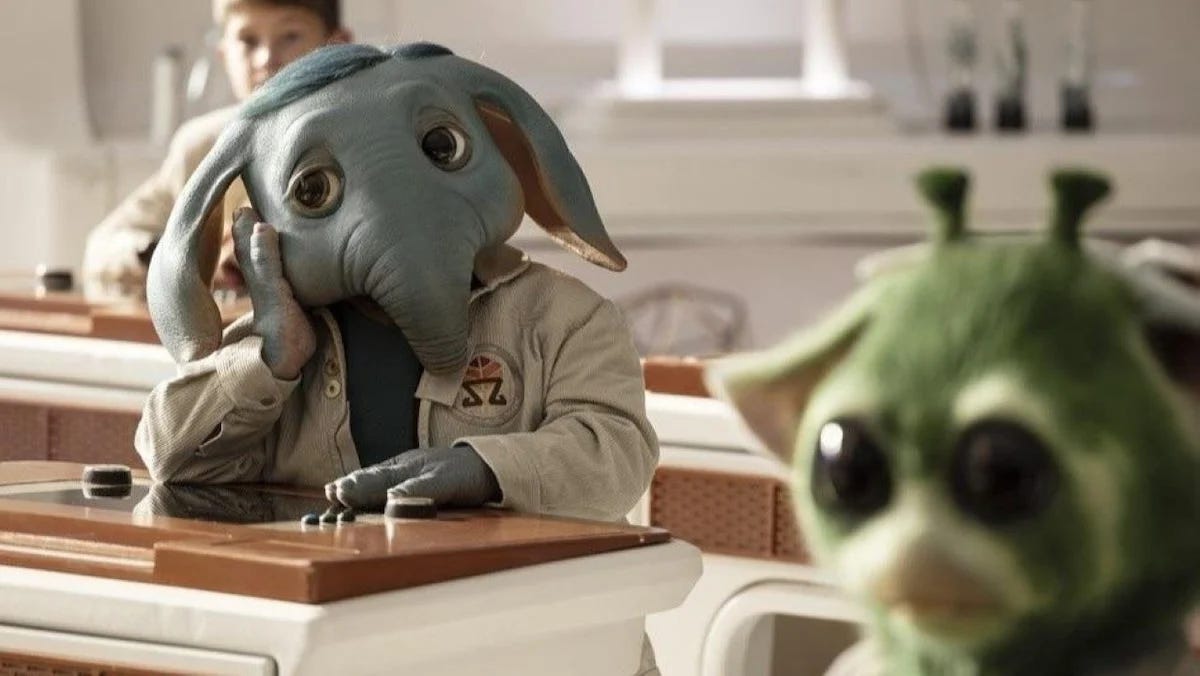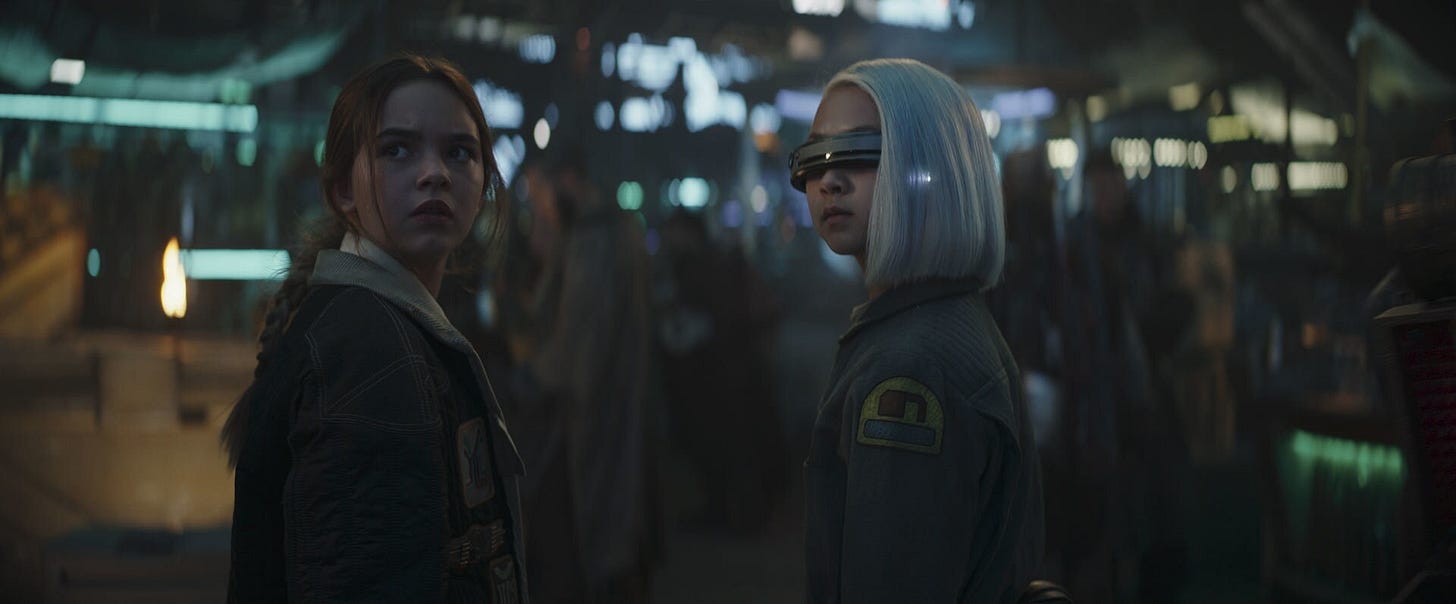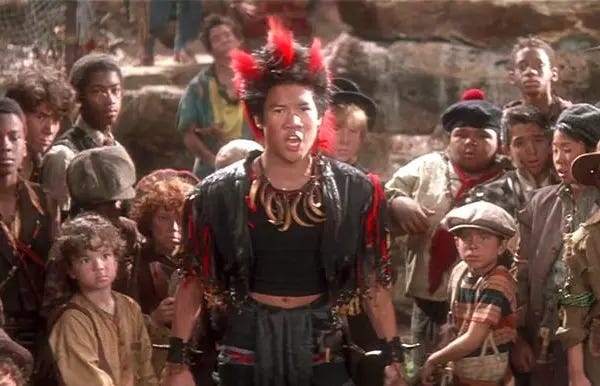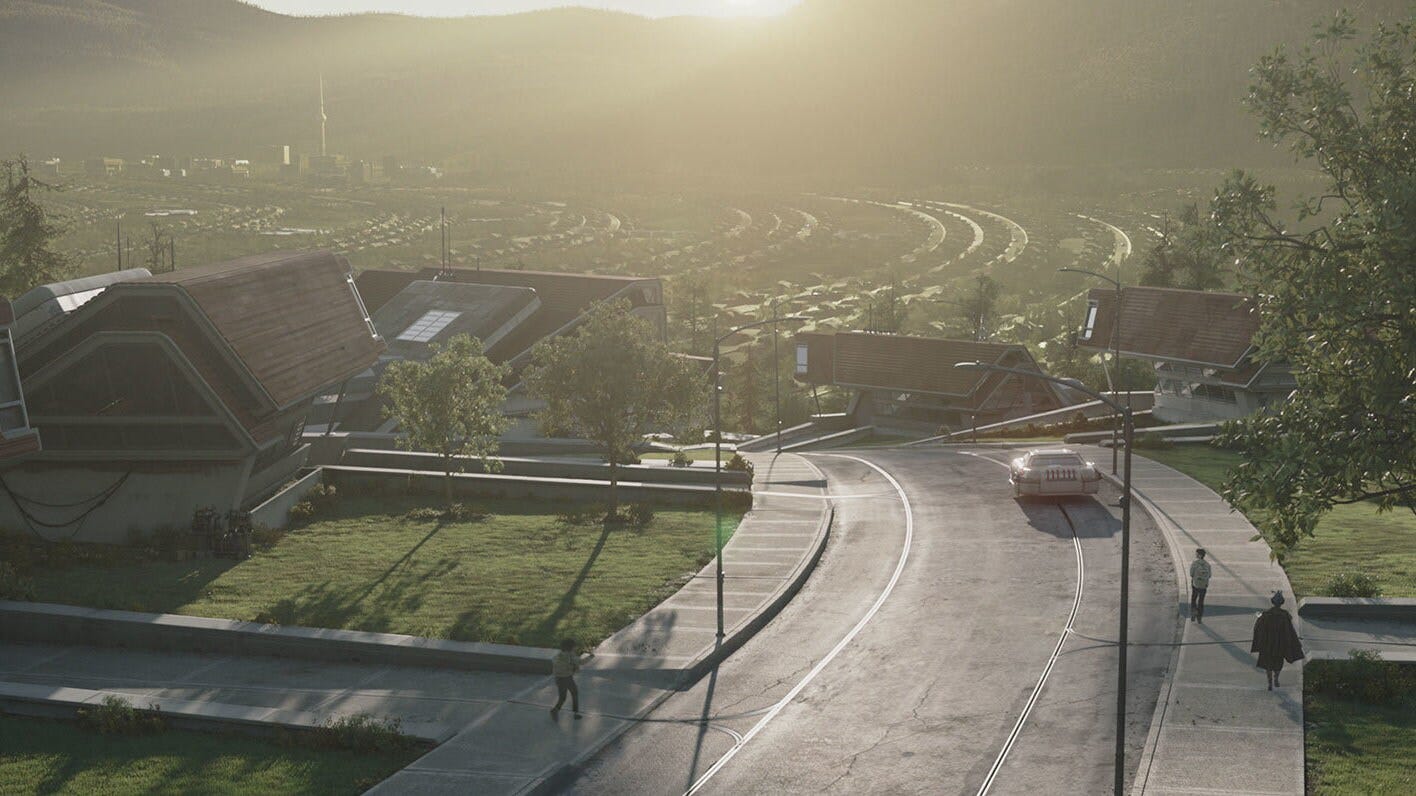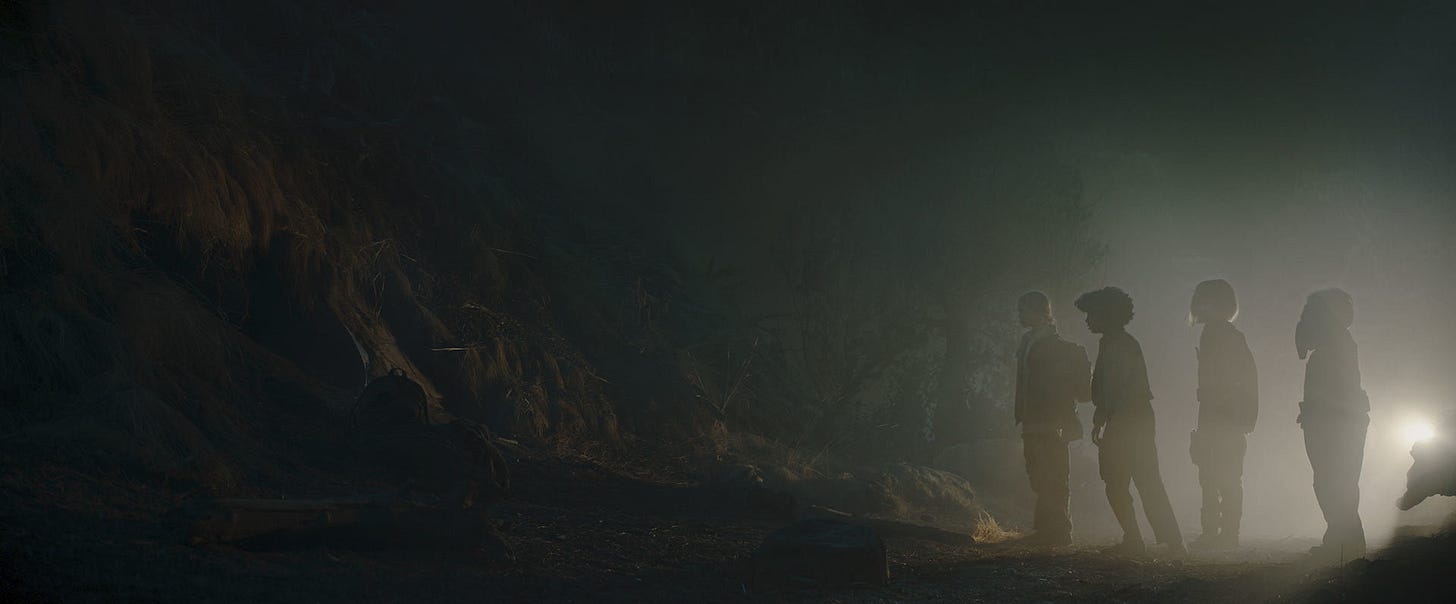The Skeleton Crew premiere does not amble with Amblin.
How the invocation of early Spielberg is not nostalgia bait for the new Star Wars series.
The Short Take:
The two-episode premiere establishes a cast of characters to care about, an unexpected mystery for the Star Wars universe, and immaculate pirate vibes. (Yarrrrrr.) A smart rather than cheap use of the Amblin legacy.
[Ahoy, SPOILERS off the starboard bow.]
Image Credit: StarWars.com
The Long Take:
It’s Goonies in space.
That’s the most common descriptor of Jon Watts and Chris Ford’s new Star Wars series, Skeleton Crew. This kind of a pitch is fairly common in Hollywood. Especially in television, the “X meets Y” or ““it’s like this, but with this” formulation is a marketing shorthand that works so well because people are more likely to understand something if you invoke that which the audience is already familiar, whether that’s studio executives or fans. The act of describing Skeleton Crew in terms of The Goonies (1985), in of itself, is not a red flag.
Yet, initially, I was suspicious of “Goonies but make it Star Wars” tag line because it implied a very overt nostalgia play for the Amblin movies of the 80s, and therefore for the bygone era of early Spielberg that depicted a simpler, happier reality in which kids could ride around on their bikes without adult supervision, get into all kinds of trouble, and ultimately be…fine. It’s easy to forget that the very title, Amblin Entertainment, is short for ambling, meaning to wander but specifically to wander in an easy, relaxed manner — unburdened by worry. This series could easily have been pure nostalgia-bait, with an empty gesture towards wistful Gen Xers’ or Millennials’ childhoods, in which they were swept up on adventures with The Goonies (1985), E.T. (1982), Hook (1991), An American Tail (1986), The Land Before Time (1988), or even Back to the Future (1985) (if Marty McFly counts as a kid).
Image Credit: Yahoo
How relieved was I, then, that Skeleton Crew is not at all cheap or exploitative of the Amblin/“Goonies in space” premise. Its sincerely charming ensemble of young characters comprises a pastiche rather than a parody or soulless homage to the wonder and glory kids experience in films like E.T. And, as I’ll discuss a little later, the series actually seems to be taking the stereotype (or can we call it an archetype now?) of 80s suburbia and turning it into a compelling exceptionalist Star Wars lore mystery.
Image Credit: StarWars.com
When we first meet Wim and Neel, they’re just two friends trying to survive epic, galaxy-shattering problems like catching the bus (sorry, tram) to school, passing a test so they won’t disappoint their parents, and working up the courage to talk to their crushes (to be fair, Roona is pretty adorable). The first episode in particular takes a lot of time — at least proportionally to an eight-episode season — to establish the mundanity of their lives. To be honest, it’s more action-less time and care spent on pure character development than we’ve seen in a minute in a Disney+ series. Sure, we open with a flash boom bang flashback of a “mysterious” Captain Silvo (who is CLEARLY Jod Na Nawood, played by Jude Law, so much so that I’m not even sure that his identity is intended to be a mystery). But after the opening scene, whose purpose may very well be to promise the audience more action in later episodes, we settle into a quieter life on At-Attin.
Image Credit: The Mary Sue
And, importantly, when that quieter life gets disrupted by a buried ship that reawakens, takes off, and travels through hyperspace to the lawless pirate haven of Port Borgo, our band of kids step up. Fern declares herself captain of their ship (I would have done anything for her), convincing salty droid SM-33 (heartily voiced by Nick Frost) to help them. And while Wim admittedly is less helpful due to his lack of self control when it comes to buttons, he’s putting his lunch money to good use and tries to keep the group together.
I’ve heard the phrase “child-like wonder” pop up in a lot of commentary about Skeleton Crew, but I’m not sure that’s quite right. To me, the Amblin spirit is less about experiencing the world innocently through a child’s eyes and more about children becoming the adults in their own stories. In Amblin films, children prevail without the help of adults or, in some cases, completely outside of adults’ knowledge. [Cue Charlie Brown style nondescript honking.] If you haven’t seen any of the films I mentioned, think of Stranger Things, which also owes a large debt of inspiration to Amblin. Think about how little the reg parents in that series (so everyone besides David Harbor or Winona Ryder) know about what’s going on and where their kids are at any given moment. In The Goonies, the police don’t believe Chunk and in the absence of a rescue from the grownups in charge, Mouth is the one who reads the map, Andy is the one who plays the bone piano, Data is the one who fends off the Fratellis with his gadgets, and Mikey leads them all (and knows to respect One-Eyed Willy, which is more than I can say for the adults).
Image Credit: LA Times
I know I said earlier that these 80s movies might make us wistful for a safer, simpler time where everyone is okay in the end, but that does not mean the danger of Amblin adventures doesn’t feel real. Going back to rewatch The Goonies, I was astonished at the violence and darkness, especially perpetrated by the villains, the Fratelli family, because I hadn’t remembered it that way at all. We’ve already seen that this might be the case in Skeleton Crew. The pirates do seem like they would actually hurt the kids, and the one nice person at the sea port seems genuinely scared that for the safety of kids running around unattended.
The pursuit of this special blend of agency, real danger, and the reassurance that it will be all right in the end is exactly why Skeleton Crew has effectively leaned so much into the pirate adventure genre thus far. We’re not getting pirates because pirates are cool (though they are). We’re not getting pirates for pirates’ sake. Pirate tales are the perfect vehicle for a child endangerment turned child empowerment arc because pirates are fantastical (and sometimes silly) enough that they can match plucky kid energy, yet dangerous enough to create real stakes within a narrative.
Image Credit: StarWars.com
Within the Amblin canon, The Goonies clearly follows this formula because Mikey and friends are literally searching for a dead pirate’s treasure; Hook, of course, remixes J.M Barrie’s works featuring Peter Pan for the late 80s/early 90s, but the narrative engine of Spielberg’s fantasy adventure is the irony that adult Peter is more helpless than all of the Lost Boys, who act like they’re are in charge. Only by rediscovering his inner child — his sense of play and his sense of discovery — can Peter come into his own as a hero.
Image Credit: IndieWire
Psychologically, becoming the hero of your own story is a coping mechanism. The fantastical adventure serves as a way for the child hero to face their fears and feel a sense of agency in the wake of “adult” problems that seem outside of their control or comprehension. In The Goonies, for example, the kids know that their houses are about to be foreclosed upon so that a country club development can take over the land. One could argue that E.T. is really about kids processing a divorce. In Hook, it’s the strained relationship between Peter (who is a workaholic like Wim’s dad) and his wife and kids. In Skeleton Crew, it’s the loss of Wim’s mother and his strained relationship with his workaholic father who won’t read him a bedtime story. It’s the pressure to achieve that Fern feels from her high-powered mother. It’s all of their anxiety about how they’re going to do on their career assessment and how they are going to fit into “The Great Work.” Those are complicated, messy concerns. But fighting pirates and trying to get home? Those are much clearer, easier to conquer stakes.
Just typing “The Great Work” sent shivers down my spine because everything we learn about At-Attin, even before the second episode reveals that no one else seems to know what or where it is, screams dystopian utopia. Think Lois Lowry’s The Giver. Or Veronica Roth’s Divergent. Or Suzanne Collins’ The Hunger Games. Whatever YA science fiction you prefer. I have a feeling that we’re about to learn so much more about the Pleasantville-esque perfection of At-Attin in the coming weeks.
Image Credit: StarWars.com
As I briefly mentioned earlier, I think this is a fresh, innovative use of the Amblin allusion because instead of making the entire show modeled after an American suburb with kids on bikes, At-Attin is an exceptional, mysteriously anomalous planet that has been lost to time in its barrier bubble. (I immediately raised an eyebrow, for example, when they said Old Republic credits instead of New Republic credits.) During the lead up to this premiere, many fans complained that an American suburb had no business in Star Wars because it looked too much like our own world and therefore didn’t fit with the more futuristic Star Wars aesthetic. Now I think they don’t have a leg to stand on because At-Attin is supposed to be unlike anything we’ve ever seen in the Galaxy.
A part of coming of age is learning that your normal isn’t everyone else’s normal, and so it was brilliant for the climactic moment of this two-episode premiere to be the realization that the kids can’t get back to At-Attin because it, according to everyone else, doesn’t exist. How they have been raised makes them aliens in their own Galaxy far, far away. It’s an El Dorado or Atlantis situation in that At-Attin seems to only exist in myth. It’s Themiskyra. It’s….Peridea? (I wish I had more time to follow that thread!)
Image Credit: StarWars.com
Whatever At-Attin actually is, and however At-Attin contrasts what it has been purported to be in legend and myth, Skeleton Crew seems to leverage its references to Amblin adventures in order to tell a story about kids gaining exposure to the outside world and only then being able to turn a more critical eye towards the home they’ve always known. That has the potential to be not only a fun escapade, but a rich bounty of meaning.







